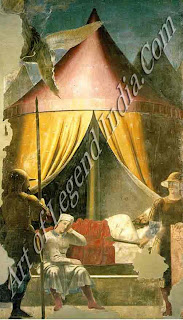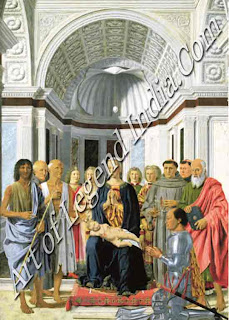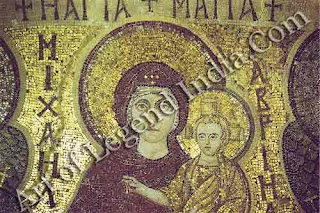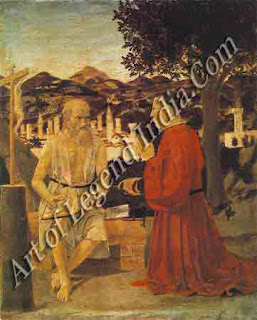 THE
PIERO DELLA FRANCESCA AT WORK
THE
PIERO DELLA FRANCESCA AT WORK
Austere Beauty
A
mathematician as well as an artist, Piero brought to his paintings an austere
beauty of form that recalls Greek sculpture. But he was also a great colourist
and unrivalled in his handling of light.
Piero's
style is highly individual, and its distinctive qualities are very different
from those so often admired in the work of 15th-century Italian painters. In
place of decorative detail and graceful fancy, he offers geometric harmony and
a classical severity that recalls Greek sculpture. It is these features,
together with his power to capture the fall of light, and his richly harmonious
colouring, that make his work so appealing to modern eyes.
And
although he was well immersed in the sophisticated humanist culture of
Florence, Urbino and Arezzo, many of his pictures retain an almost primitive
power. The Virgin of the Madonna del Par to, the figures of the aged Adam and
Eve depicted in The Death of Adam, and the angelic musicians of The Nativity
seem to reflect an ideal of humanity that is at once simple and sublime.
Since
Piero's own writings are concerned exclusively with the technical and
mathematical aspects of paintings, we must turn to the pictures themselves for
evidence of his artistic ideals. In many respects his work is fairly
conventional. Almost all of it is on religious themes, often depicted within
the traditional framework of the altarpiece. He painted both in fresco and on
wooden panels, and seems to have come only gradually to the use of oils, which
he often employed mixed with the more familiar tempera medium.
A MASTER OF PERSPECTIVE
His
outstanding claim to purely technical originality lies in his mastery of
perspective. We can admire this in the architectural detail of such paintings
as The Flagellation and the Brera Altarpiece of Madonna and Child with Saints
and Angels. The receding floor and ceiling of the loggia in the former, and the
marble apse which frames the Madonna in the latter, are painted with formidable
precision, heightened by the exact rendering of light and shadow. We know from
Piero's theoretical treatises that this was the fruit of rigorous mathematical
research.
However,
Piero rarely pursued virtuosity for its own sake. In The Resurrection he
employs a double perspective, the soldiers before the tomb being seen from
below in foreshortening, while the upper part of the picture implies a
viewpoint level with Christ's head. But this is more than a display of
technical skill. It is a part of the painting's emotional and symbolic meaning,
which contrasts the slumbering human world with the miraculous awakening of the
risen Christ.

The
face and figure of this Christ are a fine example of Piero's rendering of the
human body. Although his men and women may sometimes seem inexpressive at first
glancy and their bearing almost always seems to be contemplative rather than
active, their vitality and nobility are never in doubt. Moreover, besides a
magisterial ability to create ideal, heroic figures, Piero showed in his work
as a portraitist that he could capture the unique character of an individual
sitter. His portraits of the Duke and Duchess of Urbino are among the most
unforgettable images of the Renaissance. It is likely that his work in fact
contains several portraits which we do not recognize as such. For instance,
Vasari tells us that the Bacci family along with other citizens of Arezzo, are
shown around the defeated King in The Battle of Heraclius and Chosroes. The
riddle of The Flagellation, too, depends for its solution on the identity of
the three men in the foreground on the right-hand side of the painting, though
we are unlikely ever to know for sure who they were or what they were talking
about.
In his
work as a whole, however, Piero's gifts as a portraitist are less central than
his power to suggest something more archetypal and timeless in the human form.
The fair-haired young man of The Flagellation and the angels of The Baptism of
Christ and The Nativity all share a serenity reminiscent of Greek sculpture. We
know that Piero, like other Renaissance artists, used models hung with soft
cloth to study how drapery fell and how the light caught it. And we might point
to some particular feature the feet, for instance, whose firm grip on the
ground is so convincing in all these cases as the secret of Piero's craft. But
such details of technique or style cannot in themselves explain the underlying
vision that the painter has so memorably realized.
COLOURS AND SPACE
 Another
aspect of that vision, and the one which perhaps gives us the most immediate
and intense pleasure, is the harmony of Piero's colours. Despite the damage
they have suffered, the Arezzo frescoes never fail to strike visitors with
their luminous freshness. This quality is seen at its best in Constantine's
Victory over Maxentius where Piero's restricted palette achieves a richly
symphonic effect. The same harmony unites the colours of the garments in
Flagellation, and brings together the two angels in the Madonna del Parto,
whose attitudes and clothing echo one another in a heraldic mirror-image.
Another
aspect of that vision, and the one which perhaps gives us the most immediate
and intense pleasure, is the harmony of Piero's colours. Despite the damage
they have suffered, the Arezzo frescoes never fail to strike visitors with
their luminous freshness. This quality is seen at its best in Constantine's
Victory over Maxentius where Piero's restricted palette achieves a richly
symphonic effect. The same harmony unites the colours of the garments in
Flagellation, and brings together the two angels in the Madonna del Parto,
whose attitudes and clothing echo one another in a heraldic mirror-image.
Still
more characteristic of Piero is the sense of airy space created by the light
that fills his skies and falls upon his landscapes. Here, he largely dispenses
with perspective, using pure colour in a way that anticipates the
Impressionists. In The Nativity, his angelic and human figures are boldly
grouped against a countryside receding far into the distance. The same effect
is even more daringly successful in the Uffizi diptych, where no middle ground intervenes
between the profiles of Federigo and Battista and the idealized landscape of
their dominions. This land appears far below and behind them and is bathed in
the clear, bright light of the Italian sky.
 THE MAKING OF A MASTERPIECE
THE MAKING OF A MASTERPIECE
The Flagellation
The
formal unity of this enigmatic masterpiece is achieved by consummate skill in
perspective, reinforced by the harmonious grouping of the figures. But its two
scenes are entirely separate. Piero has emphasized this by illuminating Christ
from a light-source behind the right-hand flagellator's arm, while the
foreground is lit from the left. The painting challenges the viewer to find
some significant connection between the scenes. Christ's suffering must have
some allegorical or symbolic meaning, but how is this related to the
conversation in the foreground? Many scholars now reject the local tradition
identifying the foreground group as Urbino courtiers. Instead, they see the
picture as a commentary on the tribulations of the Eastern Christians at
Turkish hands, an interpretation borne out by the Oriental turban worn by the
man with his back to us. The three men conversing might then be ecclesiastical
and political dignitaries, the bearded man perhaps representing the Greek
Church. But in the absence of any documentary evidence, we can only speculate
on the picture's meaning, while continuing to marvel at the intricate detail
and overall harmony of its composition.
Writer
– Marshall Cavendish
 THE
PIERO DELLA FRANCESCA AT WORK
THE
PIERO DELLA FRANCESCA AT WORK Another
aspect of that vision, and the one which perhaps gives us the most immediate
and intense pleasure, is the harmony of Piero's colours. Despite the damage
they have suffered, the Arezzo frescoes never fail to strike visitors with
their luminous freshness. This quality is seen at its best in Constantine's
Victory over Maxentius where Piero's restricted palette achieves a richly
symphonic effect. The same harmony unites the colours of the garments in
Flagellation, and brings together the two angels in the Madonna del Parto,
whose attitudes and clothing echo one another in a heraldic mirror-image.
Another
aspect of that vision, and the one which perhaps gives us the most immediate
and intense pleasure, is the harmony of Piero's colours. Despite the damage
they have suffered, the Arezzo frescoes never fail to strike visitors with
their luminous freshness. This quality is seen at its best in Constantine's
Victory over Maxentius where Piero's restricted palette achieves a richly
symphonic effect. The same harmony unites the colours of the garments in
Flagellation, and brings together the two angels in the Madonna del Parto,
whose attitudes and clothing echo one another in a heraldic mirror-image. 













0 Response to "Italian Great Artist Piero Della Francesca at Work"
Post a Comment